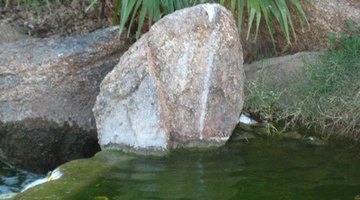How to Use a Water Well Pump to Fill a Pond
Creating a homemade pond using well water or natural stream runoff is a common form of irrigation used on farms or other properties where municipal water sources are restricted or unavailable. Underground aquifers in low lying areas offer ideal locations for ponds. However, creating a pond where there is no runoff or ground water entails diverting water from another source such as a well. Using well water to fill ponds instead of water from your municipal water source can save you money and conserve water.

-
Select your pond site and your well site. If your property is in a low-lying area with a lack of ravine runoff or natural ground water you'll need to dig out your pond and line it like a swimming pool. This will prevent oversaturation of the surrounding ground and nearby aquifer.
Geological surveys will be required to find the best location for a well using many factors, such as topography and natural vegetation. Ideally, since the pond is not the source of irrigation or well water, the well needed to fill the pond will be in a separate location from the pond itself. This will help conserve the ground water without competition from the pond or other low areas.
-
Prime your well. Depending on the type of pump and the closeness or abundance of aquifer water, well pumps will need to be primed with either forced air or water. Using water to prime a well generally means using municipal water. It is important to remember that a pump motor should never be run without water. Pump motors will burn out quickly if they are run dry.
-
Divert the well water. Using either standard hoses or, ideally, larger pvc piping, divert the well water into the pond. Ponds may require several thousand gallons of water to be filled. Calculate the volume of the pond site by multiplying the surface area with the depth to find an approximate cubic measurement.
-
Pump water in intervals. Dependent on the abundance of ground water at a pump's disposal, using too much well water in a single interval may dry up the well, rendering it useless possibly for years. Pump smaller amounts at a time to allow an aquifer to rehydrate.
-
Create a drainage system. Homemade pond water needs to drained and refilled much like a swimming pool. Stagnant pond water will breed bacteria quickly. Pond water either needs to be diverted to another natural water source such as a stream or into municipal sewer systems.
References
Warnings
- Overuse of ground water can result in dry wells. Water in certain areas is a finite commodity. Conserving water in even the most abundant sources is important to maintaining ground water over time.
Writer Bio
Eric Erickson has written professionally since 2004. He is a published poet with work appearing in "Plainsongs" and "The Curbside Review." He was a staff writer for the websites IndependentMovieReview.com and IndieMusicStop.com. Erickson received his Bachelor of Arts in English from Metropolitan State College of Denver.
Photo Credits
- rock in pond image by mtooner from Fotolia.com
More Articles



